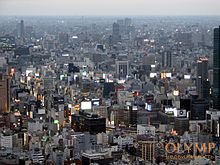
Urban agglomeration is a compact cluster of settlements, mainly urban, sometimes merging, combined into a complex multicomponent dynamic system with intensive production, transport and cultural links. The formation of urban agglomerations is one of the stages of urbanization.
There are monocentric (formed around a single major city-core, for example, the New York metropolitan area) and polycentric agglomerations (having several nucleus cities, for example, clusters of cities in the Ruhr Basin of Germany).
The proximity of settlements sometimes gives the so-called agglomeration effect - economic and social benefits by reducing the costs of the spatial concentration of industries and other economic facilities in urban agglomerations [1].
The criteria for combining territories in different countries are different. But the main generally accepted criteria for combining cities and settlements into one agglomeration are:
Not considered:
An example of the established criteria for agglomeration is the definition of the term “agglomeration” adopted by the Swiss Federal Statistical Office [2], namely:
a) agglomerations unite several municipalities with at least 20 thousand inhabitants;
b) each agglomeration has a main zone, the core of the city, including at least 10 thousand inhabitants;
c) each agglomeration community has at least 2 thousand people of working age, of which at least 1/6 are employed in the main city (or groups of main cities for polycentric agglomeration),
d) for polycentric agglomeration additional criteria can be:
Agglomerations in the developed countries concentrate considerable masses of the population. The growth of agglomerations reflects the territorial concentration of industrial production and labor resources. The spontaneous growth of agglomerations sometimes leads to the formation of a megalopolis (superaglomeration or over-agglomeration), to the largest form of settlement.
The conurbation - (from lat. Con - together and urbs - the city),
The most significant conurbations (polycentric agglomerations) were formed in Europe - the Ruhr in Germany (according to various estimates, depending on the composition of the cities included, from 5 to 11.5 million inhabitants), Randstad Holland in the Netherlands (about 7 million).
The largest in the world is the metropolitan area, headed by Tokyo, which has 38 million inhabitants. According to the UN estimates, in 2010 there were about 449 agglomerations with more than 1 million inhabitants on Earth, including 4 over 20 million, 8 over 15 million, 25 over 10 million, 61 over 5 million 6 more than 10 millionaire agglomerations: China (95), USA (44), India (43), Brazil (21), Russia (16), Mexico (12) [3] [4].
According to some estimates, there are up to 22 millionaire agglomerations in Russia, including 7 in non-millionaire cities. The largest Moscow agglomeration in Russia, according to various estimates, has from 15 to 17 million and is in 9-16th place in the world. Another (St. Petersburg) Russian agglomeration has from 5.2 to 6.2 million people, three (Samara-Tolyatti, Yekaterinburg, Nizhny Novgorod polycentric conurbation) - more than 2 million, Novosibirsk - about 1.8-1.9 million people .

View of Greater Tokyo (metropolitan area with a population of 38 million people)
1. The unification of Cheboksary and Novocheboksarsk - a project to unite the capital of Chuvashia, the city of Cheboksary, and its satellite city Novocheboksarsk.
The project has been discussed since the 1990s.
In 2008, the question of combining the two cities was submitted to a referendum. At the referendum held on March 2, 2008, 75.21% of Cheboksary residents who voted took part in the unification. At the same time, 60.31% of Novocheboksarsk residents who took part in the voting [1] voted against the merger of cities. The union did not take place.
Observers regarded the results of the referendum as a failure of the idea of unification [2], but since 2008 the issue has been repeatedly raised again.
It was supposed to unite the trolleybus systems of the two cities, as well as to launch a high-speed tram line between cities (districts) through the so-called 40,000th New City, built on the free territory between Cheboksary and Novocheboksarsk.
2 The idea of merging Saratov and Engels has a rich history . It was first announced in the late 1980s. One of the main advantages of the union was considered the possibility of building the metro.
The next company to unite the largest cities of the region started in 2007.
Supporters of the idea of unification appealed to the Saratov Regional Duma with a request to hold a national referendum. On December 20, 2007, deputies rejected the proposal. One of the reasons for the refusal was that there were two questions in the referendum: the merger and the title, while, according to the law, the question in the bulletin should be put so that it could only be answered with “yes” or “no” .
The idea of unification is not approved by the authorities of Engels, whose status in this case will be reduced to the district one. The opinion of the population in this case remains unheard.
Cities have a very close geographical location. At present, cities have a common infrastructure: power grids, information and fiber optic lines, dams, and a common ring road are common. Until 2004, there was a common trolleybus system (it was disconnected due to technical problems). In addition, no official maps of Saratov and Engels have been issued since 2001.
The de facto merger has almost happened, and it remains only to recognize it officially, since many residents of these cities already consider them appendages to each other.
Что бы оставить комментарий войдите
Комментарии (0)